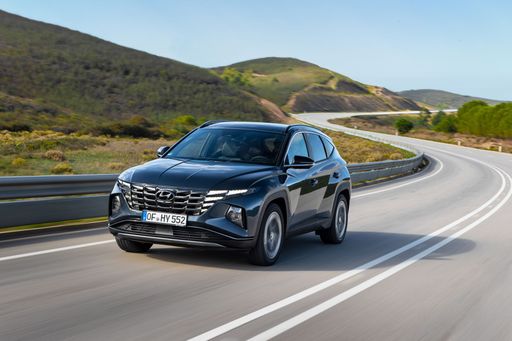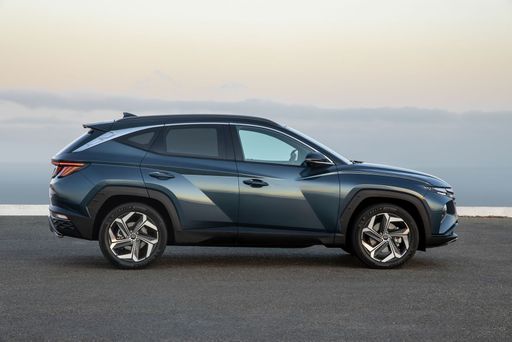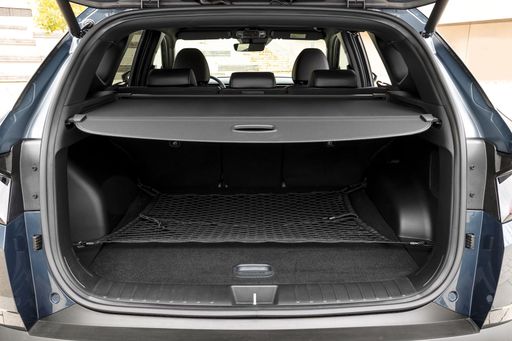Hyundai Tucson vs MG HS/EHS – Which car suits you better?
Two cars, one duel: Hyundai Tucson meets MG HS/EHS.
Which one wins in performance, efficiency and value for money? Find out now!
Here’s where it gets real: The technical differences in detail
Costs and Efficiency: Price and efficiency are key factors when choosing a car – and this is often where the real differences emerge.
MG HS/EHS has a noticeable advantage in terms of price – it starts at 24000 £, while the Hyundai Tucson costs 30600 £. That’s a price difference of around 6643 £.
Fuel consumption also shows a difference: the MG HS/EHS manages with 0.50 L and is therefore convincingly more efficient than the Hyundai Tucson with 1 L. The difference is about 0.50 L per 100 km.
As for range, the MG HS/EHS performs noticeable better – achieving up to 100 km, about 30 km more than the Hyundai Tucson.
Engine and Performance: Power, torque and acceleration are the classic benchmarks for car enthusiasts – and here, some clear differences start to show.
When it comes to engine power, the MG HS/EHS has a slight edge – offering 272 HP compared to 252 HP. That’s roughly 20 HP more horsepower.
In acceleration from 0 to 100 km/h, the MG HS/EHS is to a small extent quicker – completing the sprint in 6.80 s, while the Hyundai Tucson takes 7.90 s. That’s about 1.10 s faster.
In terms of top speed, the MG HS/EHS performs hardly perceptible better – reaching 195 km/h, while the Hyundai Tucson tops out at 194 km/h. The difference is around 1 km/h.
There’s also a difference in torque: the Hyundai Tucson pulls hardly perceptible stronger with 367 Nm compared to 350 Nm. That’s about 17 Nm difference.
Space and Everyday Use: Whether family car or daily driver – which one offers more room, flexibility and comfort?
Both vehicles offer seating for 5 people.
In curb weight, the Hyundai Tucson is barely noticeable lighter – 1520 kg compared to 1625 kg. The difference is around 105 kg.
In terms of boot space, the Hyundai Tucson offers slightly more room – 620 L compared to 507 L. That’s a difference of about 113 L.
In maximum load capacity, the Hyundai Tucson performs slightly better – up to 1799 L, which is about 315 L more than the MG HS/EHS.
When it comes to payload, Hyundai Tucson clearly perceptible takes the win – 545 kg compared to 400 kg. That’s a difference of about 145 kg.
All in all, the MG HS/EHS shows itself to be is largely superior and secures the title of DriveDuel Champion.
It impresses with the more balanced overall package and proves to be the more versatile companion for everyday use.
Hyundai Tucson
The Hyundai Tucson is a standout choice in the compact SUV segment, offering a perfect blend of style, comfort, and practicality. Its modern design is complemented by a spacious interior that provides ample room for passengers and luggage alike. With advanced technology and safety features, the Tucson ensures a smooth and enjoyable driving experience.
details @ hyundai.news
@ hyundai.news
 @ hyundai.news
@ hyundai.news
 @ hyundai.news
@ hyundai.news
 @ hyundai.news
@ hyundai.news
 @ hyundai.news
@ hyundai.news
MG HS/EHS
The MG HS, also known as the EHS in its hybrid variant, is a midsize SUV that combines modern design with a focus on comfort and technology. Its spacious interior offers a premium feel, enhanced by quality materials and an array of advanced features aimed at ensuring a smooth driving experience. Known for its efficiency, the MG HS/EHS delivers an enjoyable ride whether navigating city streets or taking on longer road trips.
details

|
|
|
|
|
Costs and Consumption |
|
|---|---|
|
Price
30600 - 46300 £
|
Price
24000 - 36000 £
|
|
Consumption L/100km
1 - 6.9 L
|
Consumption L/100km
0.5 - 7.6 L
|
|
Consumption kWh/100km
-
|
Consumption kWh/100km
-
|
|
Electric Range
64 - 70 km
|
Electric Range
100 km
|
|
Battery Capacity
-
|
Battery Capacity
-
|
|
co2
22 - 156 g/km
|
co2
14 - 173 g/km
|
|
Fuel tank capacity
42 - 54 L
|
Fuel tank capacity
55 L
|
Dimensions and Body |
|
|---|---|
|
Body Type
SUV
|
Body Type
SUV
|
|
Seats
5
|
Seats
5
|
|
Doors
5
|
Doors
5
|
|
Curb weight
1520 - 1889 kg
|
Curb weight
1625 - 1930 kg
|
|
Trunk capacity
546 - 620 L
|
Trunk capacity
441 - 507 L
|
|
Length
4510 - 4520 mm
|
Length
4655 - 4670 mm
|
|
Width
1865 mm
|
Width
1890 mm
|
|
Height
1650 mm
|
Height
1663 - 1664 mm
|
|
Max trunk capacity
1721 - 1799 L
|
Max trunk capacity
1291 - 1484 L
|
|
Payload
525 - 545 kg
|
Payload
400 kg
|
Engine and Performance |
|
|---|---|
|
Engine Type
Diesel MHEV, Petrol MHEV, Petrol, Full Hybrid, Plugin Hybrid
|
Engine Type
Petrol, Plugin Hybrid, Full Hybrid
|
|
Transmission
Automatic, Manuel
|
Transmission
Manuel, Automatic
|
|
Transmission Detail
Dual-Clutch Automatic, Manual Gearbox, Automatic Gearbox
|
Transmission Detail
Manual Gearbox, Dual-Clutch Automatic, Automatic Gearbox
|
|
Drive Type
Front-Wheel Drive, All-Wheel Drive
|
Drive Type
Front-Wheel Drive
|
|
Power HP
136 - 252 HP
|
Power HP
170 - 272 HP
|
|
Acceleration 0-100km/h
7.9 - 11.6 s
|
Acceleration 0-100km/h
6.8 - 9.6 s
|
|
Max Speed
180 - 194 km/h
|
Max Speed
190 - 195 km/h
|
|
Torque
265 - 367 Nm
|
Torque
275 - 350 Nm
|
|
Number of Cylinders
4
|
Number of Cylinders
4
|
|
Power kW
100 - 185 kW
|
Power kW
125 - 200 kW
|
|
Engine capacity
1598 cm3
|
Engine capacity
1496 cm3
|
General |
|
|---|---|
|
Model Year
2024
|
Model Year
2024 - 2025
|
|
CO2 Efficiency Class
E, F, D, B
|
CO2 Efficiency Class
F, B, D
|
|
Brand
Hyundai
|
Brand
MG
|
What drive types are available for the Hyundai Tucson?
Available configurations include Front-Wheel Drive or All-Wheel Drive.
The prices and data displayed are estimates based on German list prices and may vary by country. This information is not legally binding.
